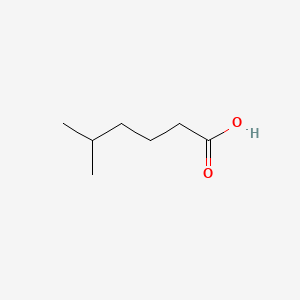| MeSH term | MeSH ID | Detail |
|---|---|---|
| Olfaction Disorders | D000857 | 17 associated lipids |
5-METHYLHEXANOIC ACID
5-METHYLHEXANOIC ACID is a lipid of Fatty Acyls (FA) class. 5-methylhexanoic acid is associated with abnormalities such as Little's Disease. The involved functions are known as inhibitors, Synthesis, Recurrence and Translation, Genetic.
Cross Reference
Introduction
To understand associated biological information of 5-METHYLHEXANOIC ACID, we collected biological information of abnormalities, associated pathways, cellular/molecular locations, biological functions, related genes/proteins, lipids and common seen animal/experimental models with organized paragraphs from literatures.
What diseases are associated with 5-METHYLHEXANOIC ACID?
5-METHYLHEXANOIC ACID is suspected in Little's Disease and other diseases in descending order of the highest number of associated sentences.
Related references are mostly published in these journals:
| Disease | Cross reference | Weighted score | Related literature |
|---|
Possible diseases from mapped MeSH terms on references
We collected disease MeSH terms mapped to the references associated with 5-METHYLHEXANOIC ACID
PubChem Associated disorders and diseases
What pathways are associated with 5-METHYLHEXANOIC ACID
There are no associated biomedical information in the current reference collection.
PubChem Biomolecular Interactions and Pathways
Link to PubChem Biomolecular Interactions and PathwaysWhat cellular locations are associated with 5-METHYLHEXANOIC ACID?
There are no associated biomedical information in the current reference collection.
What functions are associated with 5-METHYLHEXANOIC ACID?
Related references are published most in these journals:
| Function | Cross reference | Weighted score | Related literatures |
|---|
What lipids are associated with 5-METHYLHEXANOIC ACID?
There are no associated biomedical information in the current reference collection.
What genes are associated with 5-METHYLHEXANOIC ACID?
There are no associated biomedical information in the current reference collection.
What common seen animal models are associated with 5-METHYLHEXANOIC ACID?
There are no associated biomedical information in the current reference collection.
NCBI Entrez Crosslinks
All references with 5-METHYLHEXANOIC ACID
Download all related citations| Authors | Title | Published | Journal | PubMed Link |
|---|---|---|---|---|
| Ren Q et al. | Temporal and spatial expression of Muc1 during implantation in sows. | 2010 | Int J Mol Sci | pmid:20640155 |
| Suk KT et al. | In vitro antibacterial and morphological effects of the urushiol component of the sap of the Korean lacquer tree (Rhus vernicifera Stokes) on Helicobacter pylori. | 2010 | J. Korean Med. Sci. | pmid:20191039 |
| Lombion S et al. | Patterns of cerebral activation during olfactory and trigeminal stimulations. | 2009 | Hum Brain Mapp | pmid:18330871 |
| Steinert AF et al. | Hypertrophy is induced during the in vitro chondrogenic differentiation of human mesenchymal stem cells by bone morphogenetic protein-2 and bone morphogenetic protein-4 gene transfer. | 2009 | Arthritis Res. Ther. | pmid:19799789 |
| Pitteloud N et al. | Inhibition of luteinizing hormone secretion by testosterone in men requires aromatization for its pituitary but not its hypothalamic effects: evidence from the tandem study of normal and gonadotropin-releasing hormone-deficient men. | 2008 | J. Clin. Endocrinol. Metab. | pmid:18073301 |
| Tolasch T et al. | Sex pheromone of Elater ferrugineus L. (Coleoptera: Elateridae). | 2007 | J. Chem. Ecol. | pmid:17929095 |
| Moreaux L and Laurent G | Estimating firing rates from calcium signals in locust projection neurons in vivo. | 2007 | Front Neural Circuits | pmid:18946544 |
| Grossmann N et al. | Nasal airflow and olfactory function after the repair of cleft palate (with and without cleft lip). | 2005 | Oral Surg Oral Med Oral Pathol Oral Radiol Endod | pmid:16243237 |
| Page ST et al. | Exogenous testosterone (T) alone or with finasteride increases physical performance, grip strength, and lean body mass in older men with low serum T. | 2005 | J. Clin. Endocrinol. Metab. | pmid:15572415 |
| Ohta K et al. | Separation and conductimetric detection of C1-C7 aliphatic monocarboxylic acids and C1-C7 aliphatic monoamines on unfunctionized polymethacrylate resin columns. | 2004 | J Chromatogr A | pmid:15250420 |
